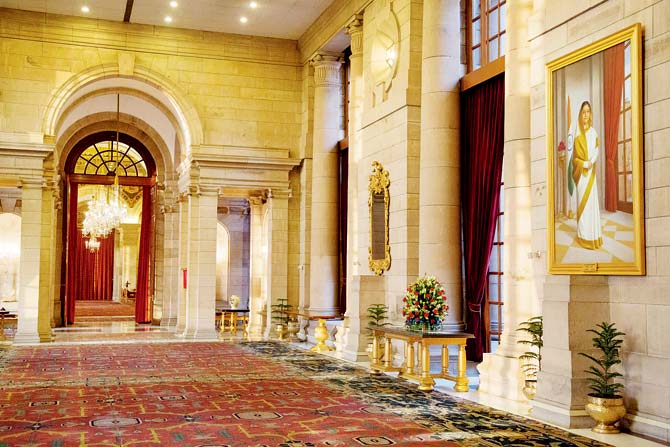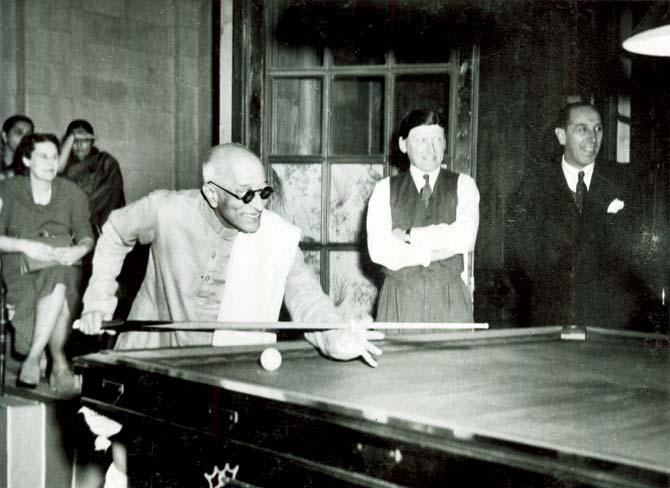The last of seven volumes published by the I&B Ministry delves into the lives of the Viceroys, Presidents and the staff that make the premier address of the nation

The lives inside Rashtrapati Bhavan

Upper Loggia of Rashtrapati Bhavan, where tea and refreshments are served after functions
A monument, a political emblem and a home all rolled into one. It is but inevitable that the Rashtrapati Bhavan – the edifice that Sir Edwin Landseer Lutyens envisioned in New Delhi as the official residence of the British Viceroys – should be the site where the Raj and independent India played out their fantasies. From polo matches and golf on a sunny morning and, parties by the pool to deciding that khadi would be the fabric of choice for all residents and domestic staff – here is a story of Indian officialdom that attempted to be sensitive and relevant to its people.

Project manager Yashaswini Chandra
It is also the story that the Rashtrapati Bhavan is keen on putting forth, as is evident from a book released on December 11, 2016 (the birthday of President Pranab Mukherjee) by the Publications Division of the Ministry of Information and Broadcasting. Titled Life at Rashtrapati Bhavan, it is the last in the series of 11 volumes and is just out for purchase on e-commerce portals. It’s a narrative of residents in the stately mansion, right from the viceregal families to the permanent staff.

C Rajagopalachari, Gandhian, prohibitionist and the last Governor-General, plays along with the pre-existing culture of the Rashtrapati Bhavan, and tries his hand at billiards. Pics/Rashtrapati Bhavan Photo Section
The series is the brainchild of Mukherjee, the 13th President of India, and was helmed since 2014 by Sahapedia, an open online resource of Indian arts, culture and heritage instituted by author and researcher Dr Sudha Gopalakrishnan.
Life at Rashtrapati Bhavan, a 200-pager priced at R1,440, follows titles on the President’s Bodyguard, dining and entertaining, and the arts and interiors of the iconic structure, among others. The project manager, art historian Yashaswini Chandra, says, "We wanted to capture the final culminating transition of the Rashtrapati Bhavan – from being a colonial home to the early days of Independence. The Bhavan is often seen solely as a public monument, and we overlook the numerous private homes of those who have served here generations after generations."
Idiosyncratic Viceroys
With both archival images and a new body of photographs by Dinesh Khanna, the book is broadly divided into two sections, the past and present. The chapters that are indicative of the need to strip away the place of elitism, if not pomp, is brought out in A Home for the Raj and A Home for India.
Despite the way it sounds, these chapters don’t paint a picture of the Raj as hedonistic and Swaraj as correctionist; at least not obviously and not all the time. Instead, it chooses to highlight the idiosyncrasies that each Viceroy, Vicereine and President brought into the premises.
Lady W, as the wife of Lord Willingdon was referred to, messed about with Lutyens’ architecture, proving to be his nemesis. She introduced "certain vulgarities" into the estate, such as flood lighting in the Mughal Gardens. On the other hand, Lord Wavell, who served as Viceroy from 1943 to 1947, was more sensitive. Taking stock of the Bengal famine and war ravages, he converted the estate’s nine-hole golf course into wheat fields. Polo was abandoned (so much so that anthills grew on the turf) as were lavish dinners.
But, as Chandra writes in the book, nothing could compare to a party at the then-Viceroy’s House; an invitation to dine with the Viceroy meant you had arrived into the beau monde of Delhi. Using the Bhavan’s holding of archival material as well as resources at the British Museum and National Museum, the book recounts visitor experiences of the dinners and galas held. The farewell banquet by the Willingdons for Indian princes is likened to a scene from the Arabian nights. "The Indian staff, especially their livery, was of much interest to the colonial elite. They were almost like props and fetishized," says Chandra, adding, "We had to balance the accounts of high-living by the colonial elite – their horse shows, parties and polo events – with the voices of the Indians, such as petitions for opening shops to cater to everyday needs within the estate and a re-look for the communal composition of the staff."
A new order
The entry of C Rajagopalachari, the last Governor-General of India, marks a change in the socio-cultural life at the Bhavan, states the book. Chandra writes that first Governor-General of independent India, Lord Mountbatten, even if more compassionate than his counterparts, and Rajaji [as Rajagopalachari was fondly known] were poles apart. "Mountbatten’s enthusiasms included polo, genealogy and decorations. Rajaji’s rested on Sanskrit, pacifism and prohibition." Among the changes that Rajaji brought into the Rashtrapati Bhavan were a prohibition on alcohol, which continues till date, and encouraging the Indian thali, instead of the Anglo-French cuisine that dominated banquet food in elite English homes.
The extras on the set
"The book is also extensively based on oral narratives of those who have lived here, generation after generation, attending to the maintenance of the estate," says Chandra. The book thus attempts to demystify the side characters in both the routine and ceremonious proceedings at the Rashtrapati Bhavan.
The estate, says Chandra, has always been notable for its amenities, many of which were a given. It was but natural that the staff would want their children to seek a job in these premises, which also came to have state-of-the-art security measures, especially in the years after the assassination of Indira Gandhi. Much like the presidential families, the domestic staff has its own history of laying claim to the Rashtrapati Bhavan estate. "The book is about the premier home of the country and not a study of the sub-altern. However, it is neither a view from the top and very much concerns the life of all individuals on the estate," says Chandra.
Today, students from the Dr. Rajendra Prasad Sarvodaya Vidyalaya use the estate as their playground. Bicycles are encouraged within the estate. President Mukherjee has been credited, through the course of the book, with his vision for a "smart city" – a term that has been trending under the Modi governance and often disparagingly used by his critics. "The Rashtrapati Bhavan can be viewed as a microcosm, a model township for the rest of India," says Chandra.
 Subscribe today by clicking the link and stay updated with the latest news!" Click here!
Subscribe today by clicking the link and stay updated with the latest news!" Click here!







